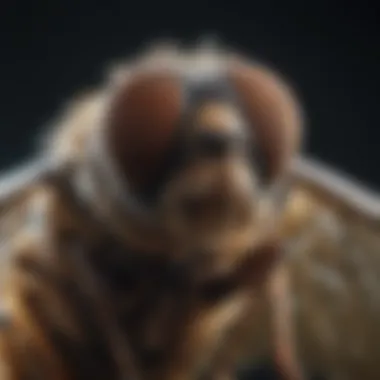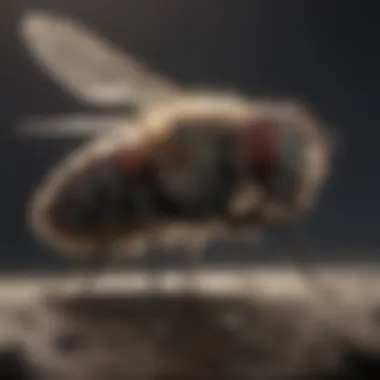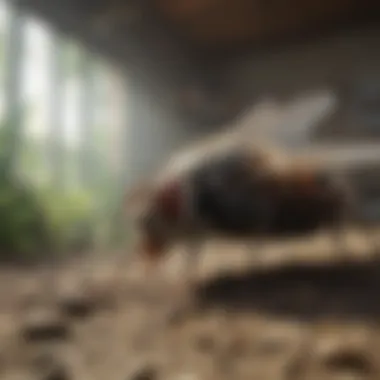Comprehensive Guide to Cluster Fly Extermination


Understanding the Pest
Cluster flies, Pollenia nigriceps, are nuisance pests that commonly invade homes during the colder months. Recognizing these flies is crucial for effective management. They are often mistaken for houseflies but can be identified by their larger size and distinct golden hairs on their bodies. Furthermore, cluster flies are sluggish and tend to gather in large numbers, particularly in attics or wall voids as they seek warmth.
Identification
Visual identification of cluster flies can help determine the appropriate control measures. Cluster flies have the following characteristics:
- Size: Typically 8 to 10 mm in length.
- Color: Dark gray-body with yellowish or golden hairs.
- Behavior: They move slowly and are commonly found in sunlit areas.
These attributes aid in distinguishing them from other fly species, which is essential for effective extermination.
Life Cycle
Understanding the life cycle of cluster flies provides important insights into their behavior and control. The life cycle can be divided into four stages:
- Eggs: Female cluster flies lay approximately 100 to 200 eggs, usually in soil or decaying organic matter. This happens typically in late summer or early fall.
- Larvae: The eggs hatch into larvae that invade earthworms, which they use for sustenance while developing.
- Pupae: After feeding, larvae pupate in the soil, eventually transforming into adults. This stage can take several weeks to months, depending on environmental conditions.
- Adults: Once mature, adult cluster flies migrate to homes to seek shelter during cooler months.
With this comprehensive view of their life cycle, homeowners can better understand why cluster flies enter structures and when they are most active.
Pest Prevention Strategies
Preventive measures are critical for minimizing the chances of cluster fly infestations. These strategies focus on environmental management and physical barriers.
Environment Modification
Adjusting the environment around the home can significantly reduce the risk of cluster flies. Consider the following actions:
- Remove Debris: Clear away piles of wood, leaves, or other organic matter from around the home.
- Maintain Gardens: Ensure your garden does not harbor decaying plants or other organic materials that can attract flies.
- Seal Cracks: Inspect for and seal cracks and openings in walls, foundations, and around utility entries.
By modifying the environment, you reduce the likelihood of cluster flies finding suitable breeding grounds.
Physical Barriers
Using physical barriers can significantly hinder cluster flies from entering your home. Techniques include:
- Screens: Install fine-mesh screens on windows and doors to prevent access.
- Sealing Entry Points: Use caulk or foam to seal gaps in windows and door frames.
Ensuring these barriers are in place can be an effective long-term solution against cluster fly invasions.
Control Methods
Even with preventative strategies, cluster flies may still find their way into dwellings. It is essential to implement effective control methods to manage these pests.
Chemical Control
Chemical extermination methods include using insecticides available in various formats such as sprays and foggers. However, caution is necessary when selecting and applying these products.
- Bifenthrin and Lambda-cyhalothrin are effective for targeting adult flies.
- Always read and follow label instructions carefully.
Biological Control
For those seeking eco-friendly methods, biological control could provide an effective alternative. This approach involves:
- Introducing Natural Predators: Certain birds and beneficial insects prey on cluster flies, reducing their population.
- Unwanted Organism Management: Ensuring that conditions are unfavorable for breeding will decrease their numbers naturally.
This method requires patience and a deeper understanding of the local ecosystem.
Effective management of cluster flies involves both proactive prevention and responsive extermination strategies to maintain a pleasant living environment.


Understanding Cluster Flies
Understanding cluster flies is crucial for effective management and eradication strategies. These pests may seem trivial, yet they can cause significant discomfort and even damage if left unchecked. The more one knows about their biology and behavioral patterns, the better equipped they will be to prevent infestations. This section is designed to provide a detailed overview of cluster flies, focusing on their biology, life cycle, and behavior. By grasping these concepts, homeowners will gain insights that are essential to address the problems posed by these flies.
Biology of Cluster Flies
Cluster flies, scientifically known as Pollenia rudis, are a type of blowfly. They are often found in homes, especially during the cooler months as they seek shelter. One of the distinguishing features of cluster flies is their size; they are larger than typical house flies, measuring about 8 to 10 mm in length. Their bodies are often a darker shade of gray with golden hairs on their back, giving them a unique appearance.
These flies are not only known for their size but also for their slow, lazy flying patterns. Unlike other flies, they tend to rest for longer periods, making them easy targets for traps. Understanding their biology helps homeowners recognize them more easily, and it assists pest control professionals in choosing the right strategies for extermination.
Life Cycle and Reproduction
The life cycle of cluster flies typically consists of four stages: egg, larva, pupa, and adult. Female cluster flies can lay hundreds of eggs, usually in soil, where the larvae will later emerge to feast on earthworms. Interestingly, the larvae develop and pupate in the soil before emerging as adult flies. This connection to the soil is important, as it means that controlling their population might require addressing both indoor and outdoor spaces.
Cluster flies reproduce in warm weather, and infestations often escalate during the fall and late summer months. Recognizing this cycle allows homeowners to anticipate potential invasions. A proactive approach during these periods can mean the difference between a manageable situation and a full-on infestation.
Behavioral Patterns
Cluster flies display distinct behavioral patterns that set them apart from other household pests. During the day, they are generally seen resting in warm areas of a building, often on windowsills or walls that receive sunlight. They prefer warm and sheltered environments for overwintering.
In addition to resting on warm surfaces, cluster flies are known to swarm in large numbers, particularly before entering homes. This behavior can be alarming for homeowners. Though they do not bite or cause direct harm, their presence can be a nuisance. Understanding these behavioral patterns can help individuals implement preventative measures early, reducing the chance of an infestation as temperatures drop.
"The better you understand cluster flies, the more equipped you are to deal with them effectively."
In summary, understanding cluster flies encompasses more than just recognizing them. It involves a careful look at their biology, life cycle, and behaviors. This will empower homeowners to manage their environment proactively. Increased awareness can lead to timely interventions, ultimately safeguarding living spaces from potential infestations.
Identifying Cluster Fly Infestations
Identifying the presence of cluster flies within a residence or building is crucial for effective pest management. Timely recognition allows homeowners to take appropriate measures, preventing escalation into a larger infestation. Understanding the signs and behavior of cluster flies enables individuals to react before serious problems arise. Ultimately, anticipating these pests' movements can save time, resources, and potential health risks.
Signs of an Infestation
Recognizing the signs of cluster fly infestation can be the first step in addressing the situation. Some common indicators include:
- Unexpected Fly Activity: Noticing cluster flies swarming near windows or lights on warm days can be a clear signal. They are typically more active during warmer months.
- Presence of Dried Excrement: Small spots of dark feces on walls or surfaces can indicate an infestation. These droppings are a direct sign of their presence.
- Increased Filth in Living Areas: Cluster flies may leave a greasy residue on surfaces. This happens as they rub against various objects while moving.
- Dead Flies: Finding dead flies in light fixtures or windowsills is common as they often become trapped. This can signal a more significant presence within distant parts of the structure.
All these signs are essential observations that indicate whether a household might be experiencing a cluster fly issue.
Common Hiding Places
Cluster flies favor specific locations making it critical to check these areas for signs of infestation. Understanding their hiding spots can aid significantly in successful detection. Typical areas include:
- Attics and Roof Spaces: Due to the warmth, these areas attract cluster flies. They often seek shelter during colder months, congregating in large groups.
- Wall Voids: The gap between walls, particularly in older homes, can provide an ideal nest for cluster flies.
- Basements: Cool and dark places are favored by these pests. If a basement has poor ventilation, it may create a suitable environment for cluster flies.
- Window Frames and Sills: This is where they are often seen hovering, especially as they search for light.
Understanding these details about cluster fly habitats allows for better preparation and efficient strategies to deal with such infestations.
The Importance of Extermination
The necessity of exterminating cluster flies cannot be overstated. These pests, while often dismissed as a mere nuisance, can pose significant concerns for both health and property. Understanding the implications of their presence is crucial for homeowners, especially in areas prone to infestations. Effective extermination is not simply about eliminating an annoyance; it encompasses various aspects that contribute to a healthy living environment.
Health Risks Associated with Cluster Flies
Cluster flies are not just benign insects wandering through your home. They can carry pathogens and bacteria that may cause health concerns. While they do not bite or sting, their habits can lead to contamination of food and surfaces. They are known to leave behind droppings that pose potential health risks, particularly to children and individuals with weakened immune systems. In some cases, these droppings can trigger allergies or respiratory issues. The presence of cluster flies might also indicate poor sanitation or attitudes towards pest management, linking them to other infestations or more serious pest problems.
Homeowners must be aware of these health considerations. Keeping food stored properly and maintaining a clean environment can help mitigate these risks.
If ignored, the minor inconvenience of cluster flies could escalate into more significant health concerns over time.
Impact on Property


The impact of cluster flies goes beyond health; they can also affect the integrity of your property. These insects typically invade homes in large groups, particularly during the fall. Their number can overwhelm areas, making it hard to manage them effectively without proper action. Like many pests, cluster flies can contribute to the deterioration of surfaces they infest. Their secretions can cause stains or damage on walls, ceilings, and furniture, leading to additional expenses for repairs and cleaning.
Additionally, a noticeable presence of cluster flies can create a poor impression on guests and may deter potential buyers if the home is on the market. A house that appears to have a pest problem may suffer from reduced property value. Ensuring an active extermination strategy not only protects the home but also preserves its value and livability.
In summary, addressing the issue of cluster flies should not be treated lightly. The health risks they present and the impacts on property due to their presence underscore the need for effective extermination strategies.
Extermination Methods
Extermination methods are crucial in effectively managing cluster fly populations. These methods can help homeowners control and reduce infestations that often invade living spaces during certain seasons. Understanding various techniques provides options depending on personal preference, environmental impact, and effectiveness. It is essential to assess the situation before deciding on the best approach.
Chemical Extermination
Chemical extermination is one of the most commonly used methods. It specifically targets pest problems with formulated solutions that can quickly reduce pest populations. Pesticides are available in various types, each designed to address different needs.
Types of Insecticides
Types of insecticides can vary significantly.
Some are designed for indoor use, while others can be applied outdoors.
Pyrethroids are popular choices due to their rapid action against flies. Their key characteristic lies in being effective against a wide range of insects, making them versatile for several applications.
However, one disadvantage includes potential health risks if not used correctly, affecting both humans and pets.
There are also natural insecticides based on plant extracts that may be less harmful to the environment. These options can be beneficial yet may require more frequent application.
Application Techniques
Application techniques are as crucial as the type of product used. How insecticides are applied affects their efficiency and safety. Typically, methods include spraying, fogging, or utilizing bait stations. Each application technique offers distinct benefits. For instance, spraying ensures thorough coverage and quick results. However, it requires proper protection for the person applying the solution. A unique feature of some advanced techniques is the targeted application, minimizing exposure. Careful consideration of the technique contributes to safety and effectiveness during treatment.
Mechanical Control Methods
Mechanical control methods involve using physical means to eliminate or deter cluster flies without chemicals. They tend to be more environmentally friendly, making them a good choice for sensitive homeowners.
Traps and Barriers
Traps and barriers are strategic assets in fly management. They can be put in place to capture flies or prevent their entry into living spaces. The type of trap can range from sticky traps to electric zappers. They provide continuous monitoring and capture without chemicals. A primary advantage is the minimal environmental impact; however, they may require frequent checks and maintenance for effectiveness.
Vacuuming Techniques
Vacuuming techniques are another physical approach worth considering. Using a vacuum cleaner to suck up flies can be very effective. This method allows for immediate removal, especially in high-traffic areas of infestation. A distinct benefit is that vacuuming provides a clean solution, with no residues left behind. On the flip side, this requires regular attention and might be impractical for larger infestations.
Natural Extermination Techniques
Natural extermination techniques appeal to those wanting to avoid synthetic chemicals. They focus on eco-friendly options that pose less risk to the environment and health.
Essential Oils
Essential oils have gained popularity in recent years as a natural deterrent. Oils like peppermint and eucalyptus have properties that repel flies effectively. The key characteristic of essential oils is their generally pleasant scents, adding an aesthetically appealing touch. While they are often regarded as a safe alternative, their effectiveness can vary, sometimes requiring more frequent applications to maintain deterrent capabilities.
Biological Controls
Biological controls involve introducing natural predators or parasites to manage pest problems. This method contributes significantly to the overall ecosystem's balance. For instance, certain predatory insects can reduce cluster fly populations naturally. A notable advantage is sustainability. However, it necessitates careful consideration to ensure that introduced species do not become invasive themselves.
"Natural methods may take longer to show results, but provide a safe alternative to chemical treatments."
These extermination methods present viable options for homeowners dealing with cluster fly infestations. Knowledge of their characteristics helps tailor pest control strategies to individual needs.
Professional Pest Control Services
Managing a cluster fly infestation requires more than just basic knowledge of these pests. Understanding when to seek help from professionals can greatly influence the outcome of pest control efforts. Professional pest control services are tailored to address infestations effectively, ensuring a thorough approach that is difficult to achieve with DIY methods.
Engaging a pest control professional often means access to specific tools, insecticides, and techniques that are not available to the average homeowner. This can include specialized equipment for treating extensive infestations or eco-friendly solutions that minimize harm to the environment. With their expertise, these professionals can accurately identify the severity of the problem, tailor a plan, and execute it effectively.
When to Call a Professional
It is crucial to recognize the signs indicating when a professional pest control service is needed. Homeowners should consider calling a professional when:


- The infestation is large: If you notice numerous cluster flies in your home, the situation may have escalated. A larger presence often means a more significant breeding area, requiring systematic eradication.
- DIY methods are ineffective: If methods such as traps, vacuuming, or using insecticides do not yield results after consistent efforts, it may be time to reach out for professional assistance.
- Recurring infestations: If cluster flies return year after year, that suggests a persistent issue, possibly due to breeding sites outside the home.
- Uncertainty regarding health risks: If you are unsure about potential health risks associated with cluster flies, consulting a professional can provide clarity.
In these scenarios, the costs associated with professional services may be justified by the peace of mind they offer and the efficiency of their solutions.
Choosing a Reliable Exterminator
Selecting a competent pest control service is essential for effective cluster fly management. Here are some factors to consider while choosing:
- Licensing and qualifications: Ensure the exterminator holds necessary licenses and certifications. This indicates they follow industry standards and regulations.
- Experience with cluster flies: Ask about their experience specifically with cluster flies. This ensures they have knowledge of these pests and understand effective treatment options.
- Reputation: Look for reviews and testimonials from previous clients. A reliable exterminator will have positive feedback and a strong local reputation.
- Treatment methods: Inquire about the methods they use. A reliable exterminator should offer a variety of options, including chemical and eco-friendly solutions.
- Follow-up services: Check if the service includes follow-up visits to monitor effectiveness and address any return infestations.
By evaluating these aspects, you can select an exterminator who provides a tailored and effective solution to your cluster fly issue.
Preventive Measures
Preventive measures stand as the first line of defense against cluster fly infestations. Implementing these strategies can significantly reduce the chances of an infestation, saving homeowners time and money. A thorough understanding of how prevention works is key to maintaining a fly-free environment.
Specific elements of preventive measures include home maintenance and environmental considerations. These actions do not require extensive investment or time but can be incredibly effective. Not only do these strategies minimize the likelihood of cluster flies entering the house, they also promote a healthier living space overall.
Home Maintenance Tips
Regular home maintenance is essential in preventing cluster fly infestations. Homeowners can take several steps to ensure their properties remain unattractive to these pests:
- Sealing Entry Points: Inspect windows, doors, and other openings. Use weather-stripping or caulk to seal cracks and gaps.
- Screen Installation: Installing screens on windows and vents can effectively keep flies out while allowing airflow.
- Cleaning the Exterior: Keep the exterior clean and free of debris. Remove any decaying plant matter or organic waste, as these attract cluster flies.
- Proper Drainage: Ensure that gutters and downspouts direct water away from the foundation. Standing water can attract flies looking for moisture.
- Regular Inspections: Routine inspections of attics and basements can help identify potential cluster fly entries before they become a problem.
Environmental Considerations
Environmental factors play a significant role in attracting cluster flies. Understanding these elements can aid in effective prevention:
- Landscape Management: Maintain a clean and tidy garden. Trim trees and bushes to reduce shady areas where cluster flies might rest.
- Avoiding Overwatering: Watering gardens too much can create favorable conditions for breeding. Water early in the morning to allow evaporation during the day.
- Removing Compost Piles: Compost piles can attract cluster flies due to their organic material. If possible, consider alternative options for composting.
- Reducing Clutter: Clutter can provide hiding spots for cluster flies. Keep areas like garages and basements organized and clutter-free.
Remember: Preventing cluster flies is much easier than trying to control them once they invade your space. Taking proactive steps can save considerable effort in the long run.
By focusing on diligent home maintenance and considering the environmental aspects, homeowners can greatly diminish the risk of cluster fly infestations. Simple yet effective practices ensure homes remain resilient against unwanted visitors.
Post-Extermination Considerations
Post-extermination considerations are crucial in ensuring that the measures taken against cluster flies remain effective over time. This section emphasizes the importance of ongoing monitoring and preventive strategies to safeguard your home from potential reinfestation. Understanding how to maintain a cluster fly-free environment not only protects your property but also enhances your overall peace of mind.
Monitoring for Reinfestation
After the initial extermination process, vigilance is key. Monitoring for reinfestation allows homeowners to spot problems before they escalate. Here are important elements to consider:
- Establish Regular Inspections: Make it a routine to inspect potential entry points in your home, such as windows, doors, and crawl spaces. Look for any signs of cluster flies, such as their distinctive presence around light sources.
- Use Traps: Consider implementing low-tech traps around your property. These can help catch cluster flies early, allowing you to assess the effectiveness of your extermination efforts.
- Keep Records: Document any sightings or evidence of cluster flies. This record can provide insight into trends and help inform future extermination efforts if necessary.
By monitoring for reinfestation meticulously, you create an additional layer of defense against cluster flies.
Long-Term Prevention Strategies
To sustain a cluster fly-free home, long-term prevention strategies are essential. These methods not only discourage cluster flies from returning but also improve your general living conditions. Consider implementing these strategies:
- Sealing Entry Points: Ensure that all cracks, gaps, and holes in your home’s exterior are sealed properly. This includes areas around windows, doors, and utility lines. Consider using caulk or weather stripping to enhance your home's defenses.
- Maintain Cleanliness: Regular cleaning, particularly in areas where cluster flies might congregate, helps deter their presence. Store food in sealed containers and promptly clean up spills or crumbs.
- Landscaping Changes: Modify your landscaping to reduce breeding sites. Keep shrubs and weeds trimmed, and if possible, create distance between plants and your building.
- Install Screens: Use window and door screens, and make sure they are free from tears or holes. This effective barrier can prevent cluster flies, as well as other unwanted pests, from entering your home.
Epilogue
The conclusion of this article serves as a critical point for understanding the comprehensive management of cluster fly infestations. It summarizes essential insights and recommendations from all sections of the guide, reinforcing the best practices for both extermination and prevention.
The importance of addressing cluster flies cannot be overstated. These pests not only disrupt the comfort of living spaces but also pose various health risks. They can contaminate food sources and create unsanitary conditions. Therefore, understanding their biology, life cycle, and behavioral patterns lays a foundational knowledge for effective control.
Summary of Key Insights
- Recognition of Infestation: Identifying the signs and common hiding places of cluster flies is vital for timely action. Homeowners should always remain vigilant to notice large swarms or dead flies, particularly in late summer or fall.
- Extermination Strategies: Employing a combination of chemical, mechanical, and natural extermination methods will enhance the effectiveness of control measures. Each method has its benefits, so selecting the right approach depends on individual situations and preferences.
- The Role of Professionals: Knowing when and how to enlist the help of professional pest control services is essential. Their expertise can lead to more thorough and long-lasting solutions compared to DIY efforts.
- Preventive Measures: Maintaining a clean home and addressing potential entry points are fundamental to prevent future infestations. Regular maintenance and being proactive can save considerable time and resources.
In essence, this article aims to provide readers with a well-rounded understanding of cluster fly extermination. The knowledge presented here empowers homeowners to take initiative in managing these pests effectively. By combining proper identification, extermination methods, and preventive strategies, one can significantly reduce the likelihood of cluster fly problems in the future.
"Knowledge is power. By understanding these nuisances, homeowners can reclaim their spaces from cluster flies."







